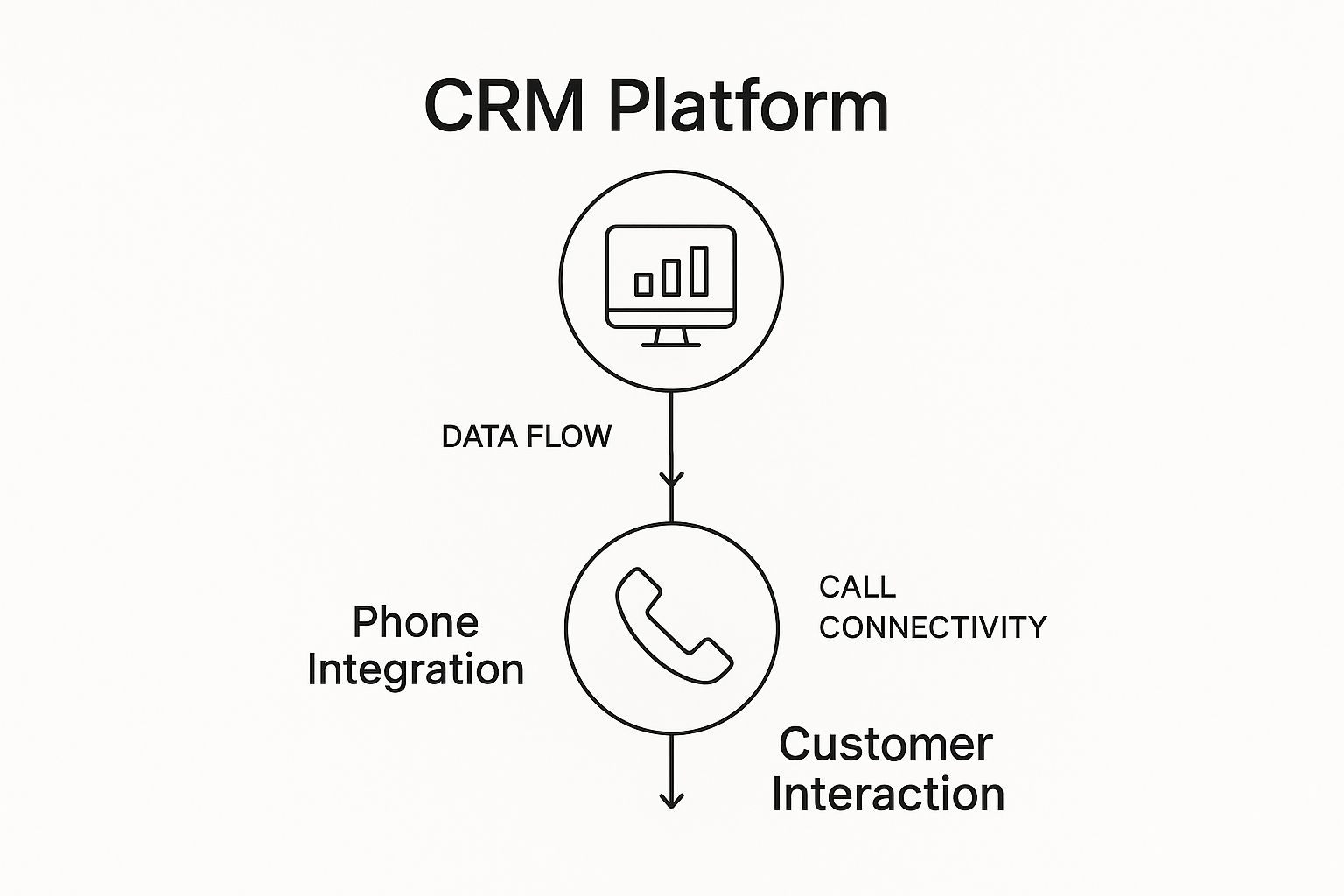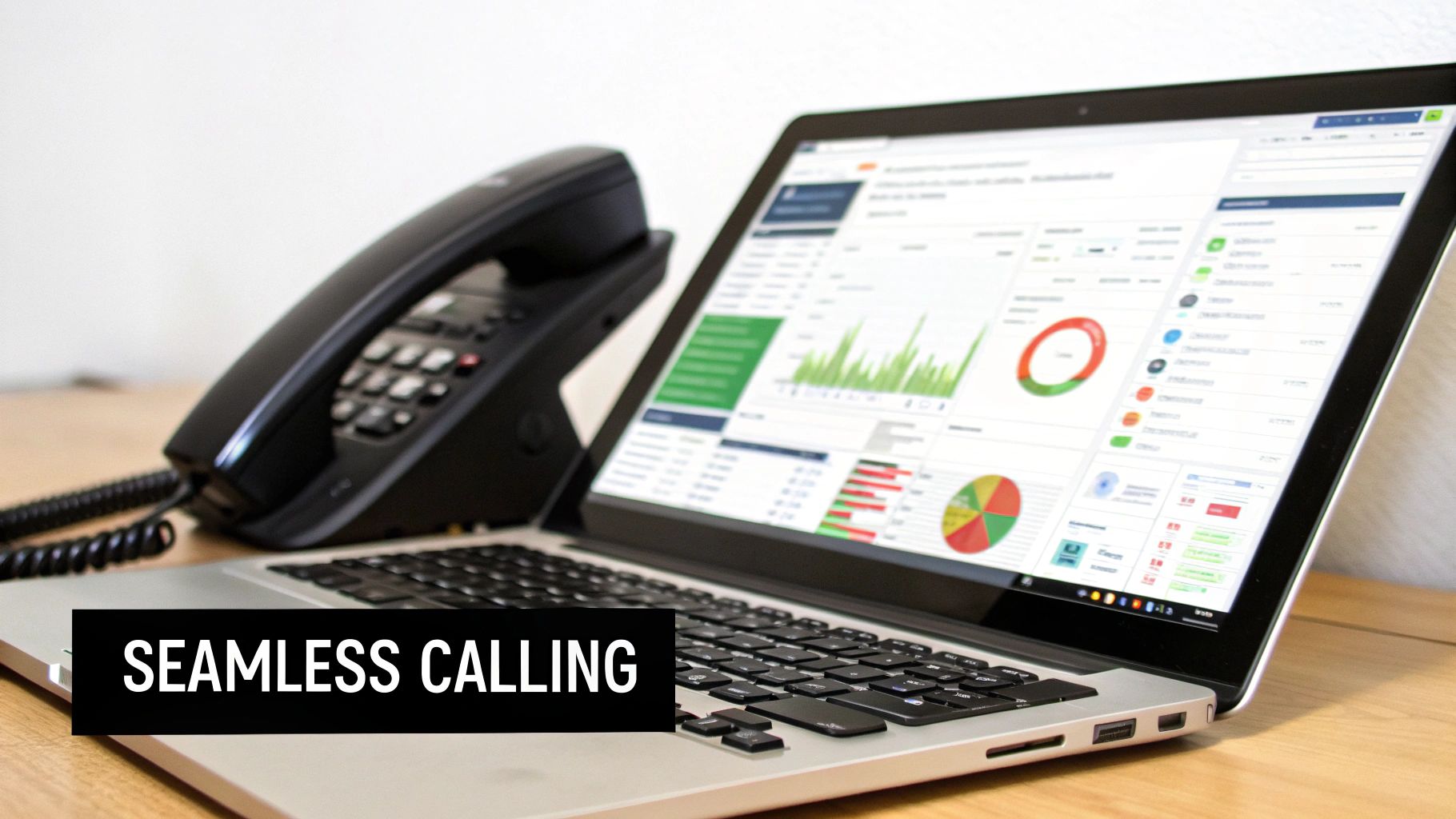A CRM with phone integration is exactly what it sounds like: connecting your business phone system directly to your customer relationship management software. In practice, this means customer data instantly pops up when they call, and every detail from that call is automatically logged right back into their profile. It turns every single conversation into a smarter, more productive interaction.
Let’s use an analogy. Think of your CRM as your business's central brain. It holds every piece of information you have on your customers—what they’ve bought, their support tickets, contact details, you name it. Your phone system, on the other hand, is how you talk and listen to them.
Without integration, the brain and the mouth are working in separate rooms. Your team has to manually run back and forth, piecing together information while a customer waits on the line. It's clunky and inefficient.
A CRM with phone integration acts as the nervous system connecting that brain (the CRM) to the ears and mouth (the phone). The moment a call comes in, the system recognizes the number and instantly pulls up the caller's complete profile. No more frantic searching for context. Your team can greet customers by name and know their entire history from the very first "hello."
This seamless link does more than just save a few seconds here and there; it fundamentally changes the quality of your customer interactions. Instead of asking the same old questions ("Can you spell your name for me? What was your last order?"), your team can jump straight into solving problems and building real relationships.
Better yet, every conversation adds a new layer of data right back into the customer's profile, creating a richer, more accurate history over time.
This visual shows that simple but powerful flow: your CRM platform and phone system are linked, creating a feedback loop that improves every single customer interaction.

The key takeaway is that data flows both ways. It enriches your CRM and empowers your team with real-time information when it matters most—during a live call.
To see just how big of a difference this makes, let's look at a typical day for a sales or support rep. The "before" picture is probably all too familiar.
The "after" column isn't about fancy new features; it's about removing the friction that slows your team down and distracts them from what they're actually supposed to be doing: talking to customers.
The proof is in the numbers. By 2025, connecting phone systems with CRM platforms has become a non-negotiable for boosting sales and customer service. In fact, businesses that use mobile CRM systems—which are built around phone integration—are about 150% more likely to crush their sales goals than those who don't. You can dig deeper into the full impact of these tools and see how they are shaping business success by checking out the latest CRM statistics.
This integration transforms your phone from a simple communication device into an intelligent data-gathering tool that strengthens customer relationships and drives revenue.
Modern tools like My AI Front Desk are taking this concept to the next level. By adding an AI-powered layer on top, these solutions can handle the initial call, book appointments, and log all the important details into your CRM without a human ever touching it. This makes powerful technology accessible and affordable for any business, turning every inbound call into a perfectly managed opportunity.
Tying your phone system into your CRM isn't just a simple tech upgrade. It's a fundamental shift in how your business runs and, ultimately, how it grows. The real magic happens when you see the tangible, day-to-day impact this connection has on your team's performance and, by extension, your bottom line.
Think about it this way: imagine a sales rep who used to burn over an hour every single day just logging calls, updating contact records, and scheduling follow-ups by hand. With an integrated system, every call is logged automatically. That's an hour back in their pocket—not just saved time, but an extra hour they can spend actually selling. Week after week, that adds up to dozens of additional outreach calls.

This boost in raw efficiency is really just the beginning. The quality of your customer interactions is where things get really interesting.
When every call, note, and outcome is captured right in the CRM—without anyone having to remember to do it—you cut out human error and forgotten details. Suddenly, you have a pristine, reliable source of truth. Business leaders can dig into this data to make genuinely smart, data-backed decisions about sales tactics, customer service training, or even product development.
For example, a manager could review automatically transcribed call recordings to spot common customer objections. Armed with that knowledge, they can coach their team on exactly how to navigate those conversations more effectively. That’s a direct line to better conversion rates. A solid CRM with phone integration is the backbone for effective lead generation strategies that actually move the needle.
This seamless data flow creates huge wins in both productivity and customer happiness. In fact, research shows that organizations using this kind of integrated software see agent productivity jump by roughly 25% and achieve a 20-30% increase in customer satisfaction scores.
Let's look at it from the customer's perspective. Picture a customer calling with a support issue. Without integration, they might have to repeat their life story to multiple agents, getting more frustrated each time. With it, the agent sees the caller's entire history the second the phone rings.
The agent can greet them with, "Hello, Sarah. I see you called last week about the issue with your subscription. Let's pick up right where you left off."
That single moment changes everything. It transforms a potentially negative experience into one that builds trust and loyalty. The customer feels seen and valued, not like just another ticket number. It’s these small, personal touches—powered by smart technology—that forge long-term customer relationships and drive real, sustainable growth. By getting the friction out of the way, you free your team up to focus on the only thing that matters: the customer.

Think of this as your buyer's checklist. These are the core functions that separate a simple plug-in from a tool that genuinely changes how your team operates. Each one is designed to smooth out the rough edges of your workflow, make conversations better, and keep a perfect record of every customer interaction.
One of the most powerful yet straightforward features you'll find is click-to-dial. Instead of your team manually punching in numbers or fumbling with copy-and-paste, they can just click a number in a contact's CRM profile to start a call. Simple as that.
But this is way more than just a small convenience. It’s an efficiency engine.
This single feature transforms your CRM from a static database into an active outreach machine, empowering your team to connect with more people with a lot less effort.
Picture this: your phone rings. Before you even get a chance to say "hello," a "screen pop" flashes on your computer, showing the caller's entire CRM profile. You see their name, company, recent purchases, and any open support tickets. This is your secret weapon for making every call personal.
Screen pops get rid of that awkward "hang on, let me pull up your account" pause. Your team instantly has all the context they need to have a real, informed conversation.
Greet customers by name, mention their last interaction, and jump right into solving their problem. This simple touch makes customers feel seen and valued, turning a routine call into a loyalty-building experience.
Manually logging call details after hanging up is a huge productivity killer and the main reason why CRM data is often incomplete. Automatic call logging fixes this problem entirely by creating a perfect, hands-free record of every single interaction.
Once a call ends, the system automatically logs all the important details right into the CRM:
This builds an accurate, chronological history of every touchpoint without anyone lifting a finger. Your team can move on to the next conversation, knowing a flawless record has already been saved.
Finally, the ability to record and transcribe calls is a must-have for any business serious about getting better. This feature captures the whole conversation, turns the audio into searchable text, and stores it right in the customer's CRM profile.
The uses here are incredibly valuable. Sales managers can listen to call recordings to give specific coaching, while support teams can scan transcripts to spot common problems. It's also a critical tool for compliance and settling disputes, giving you an undeniable record of what was said.

The real magic of a CRM with phone integration snaps into focus when you see it working in the wild. This isn't just some high-tech toy for massive call centers. It's a practical, down-to-earth tool that gets real results for businesses in completely different fields.
Let's walk through a few examples. By seeing how others are using it, you can start to picture exactly how it could reshape your own day-to-day. These stories show how plugging your phone system into your customer database solves nagging, industry-specific problems, turning everyday calls into genuine opportunities.
For any busy real estate agent, an incoming call is money ringing. It's a potential commission, a new client, or a lead on a hot property. Now, imagine an agent gets a call. Instead of fumbling for a notepad, a screen pop instantly shows the caller's name, the specific properties they were just looking at on the website, and even their stated budget.
The conversation changes completely. Instead of a bland, "Hello, how can I help you?" the agent can say, "Hi, Alex! Great to hear from you. I see you were looking at the house on Maple Street. It's a fantastic choice. Did you have any questions about that updated kitchen?"
Right away, this creates a connection. It's a hyper-relevant conversation that builds instant rapport and frames the agent as an attentive, proactive expert who's already one step ahead.
A Software-as-a-Service (SaaS) sales team's success is often measured in two things: call volume and efficiency. Every minute spent manually dialing numbers or logging notes is a minute not spent selling.
With click-to-dial, a sales rep can power through their prospect list right from the CRM, making dozens more calls every single day without fumbling with their phone or making costly dialing errors. Better yet, every single conversation is automatically logged, and the call is recorded and attached to the contact's record.
Later, a sales manager can pull up those call recordings and transcripts. They can see exactly which pitches are landing and which ones are falling flat. This isn't guesswork; it's hard data they can use for coaching the team, refining their sales script, and ultimately, closing more deals.
Think about a local plumbing business. The owner is the expert, but they're usually out on a job, crawling under a sink, not sitting by the phone. Every missed call is a potential job down the drain.
This is the perfect spot for an AI-powered system like My AI Front Desk to jump in. The AI receptionist answers every single call, 24/7. It can qualify the lead by asking about the plumbing issue, then book an appointment directly into the business's calendar based on the owner's availability.
All of that info—the caller's details, the type of job, the scheduled appointment—gets logged automatically in the CRM. The owner can finish up a job, glance at their phone, and see a new, qualified appointment waiting for them. No missed calls, no lost revenue, no playing phone tag.
This kind of powerful, accessible automation is exactly why the global CRM market is projected to hit $262.74 billion by 2032. It's driven by mobile-first tools that solve real problems for businesses of all sizes. You can learn more about the rapid adoption of CRM technology and its impact across the board.
Here’s Your Practical Implementation Checklist
Jumping into a CRM with phone integration is a fantastic move, but a successful launch needs more than just enthusiasm—it needs a solid game plan. This isn't about flipping a switch and hoping for the best. It's about methodically preparing your tech, your team, and your goals to make sure you squeeze every drop of value from your investment. Think of this as your roadmap to a smooth, effective rollout.
A little planning up front helps you sidestep common traps and score some immediate wins. By taking a structured approach, you'll ensure everything works together, know exactly what success looks like, and get your team excited to use the new system.
First things first: before you even start window shopping for new providers, take a hard look at the tech you already have. Do you have a cloud-based VoIP system? Can your current CRM talk to modern APIs? Answering these questions now will save you from massive headaches later.
This initial check makes sure your new solution will play nicely with the tools you and your team already depend on. It’s the difference between a seamless integration and a messy, complicated overhaul.
What are you actually trying to accomplish here? Fluffy goals like "improve efficiency" won't cut it. You need to get specific and set targets you can actually measure.
Make your goals concrete. Here are a few examples to get you thinking:
Goals like these give you a clear benchmark for success. They turn a simple tech upgrade into a strategic move that justifies the investment and shows real results.
When you're checking out potential providers, look past the shiny feature list. The right partner should fit where your business is headed. Ask the tough questions: Can their system grow with you? How responsive is their customer support? Is it actually easy to use?
The best integration partner is more than just a software vendor—they're a strategic asset. A provider that offers rock-solid support and a platform that can scale will keep delivering value long after the initial setup.
For small and mid-sized businesses, a solution like My AI Front Desk is built for exactly this. It's designed to be straightforward and easy to implement without needing a dedicated IT department, putting powerful automation within reach for everyone.
Finally, remember this: the most advanced technology on the planet is useless if no one on your team uses it. The single most important part of your rollout is solid training and a real focus on getting everyone on board.
Schedule dedicated training sessions that go beyond a boring feature walkthrough. Show your team exactly how the new system makes their specific jobs easier. Point out the direct benefits to them, like less tedious admin work and more time to build relationships with customers. When you get their buy-in and make them comfortable with the new way of doing things, you guarantee your investment truly pays off.
Standard integration is a great first step—it connects your phone system to your CRM, telling you who’s calling. But what if you could add a layer of intelligence on top of that? This is where a modern approach takes your CRM with phone integration from being a simple record-keeper to a proactive, automated part of your business.
Instead of just logging calls, an AI-powered front desk actively manages them before they ever reach a human. Imagine having a 24/7 AI receptionist that answers every single call, qualifies new leads on the spot, and even schedules appointments directly into your team's calendar.
This isn’t just about trimming a few minutes off your day. It’s a direct solution to some of the biggest headaches small businesses face: missed opportunities from unanswered calls and the endless grind of administrative work.
Let’s put it this way: a standard integration is like caller ID for your business. An AI front desk is like having a fully trained assistant handle the entire first conversation for you.
When a potential customer calls, their details, the reason for their call, and a booked appointment can all just appear in your CRM—no manual typing needed. Your team only gets involved when it’s time for those high-value conversations that actually close deals.
This technology turns your phone system into an autonomous sales and service engine. It ensures no lead is ever missed and that your team’s time is reserved for closing deals and supporting existing customers.
To get a better sense of how these advanced technologies work in the real world, it's worth exploring professional AI automation services.
The benefits are immediate and easy to see:
This is the evolution from simple connection to intelligent automation. It’s what truly unlocks the power of your CRM with phone integration.
Got questions about CRM phone integration? You're not alone. Anytime you bring a new tool into your business, it’s smart to kick the tires a bit. Let's tackle some of the most common questions we hear so you can see exactly how this works.
It's a great question, and one we get a lot. People often wonder what separates a true CRM integration from a standard VoIP phone.
Think of it this way: VoIP is the highway your calls travel on. The CRM integration, on the other hand, is the smart GPS that connects that highway directly to your customer files. It gives you instant context for every call and logs all the important details automatically, without you lifting a finger.
Another big concern is always about the complexity and cost. A few years back, this kind of setup might have required a dedicated IT team and a pretty hefty budget. Not anymore.
Today’s cloud-based tools are built for regular business owners, not tech wizards. Most platforms offer a simple, guided setup that you can get done quickly, often without any specialized knowledge at all.
The best systems are designed for ease of use, ensuring that the transition to a CRM with phone integration is smooth and doesn't disrupt your daily operations or your budget.
Finally, the big one: "Do I have to change my phone number?" The answer is a resounding yes, you can keep your number.
Leading providers, including our own My AI Front Desk, are built specifically to work with your existing business number. This makes the transition completely seamless for your customers—they can keep calling the same number they’ve always used. No confusion, no lost calls.
Ready to turn every call into an opportunity? See how My AI Front Desk can automate your lead conversion and customer service by visiting https://myaifrontdesk.com.
Start your free trial for My AI Front Desk today, it takes minutes to setup!








